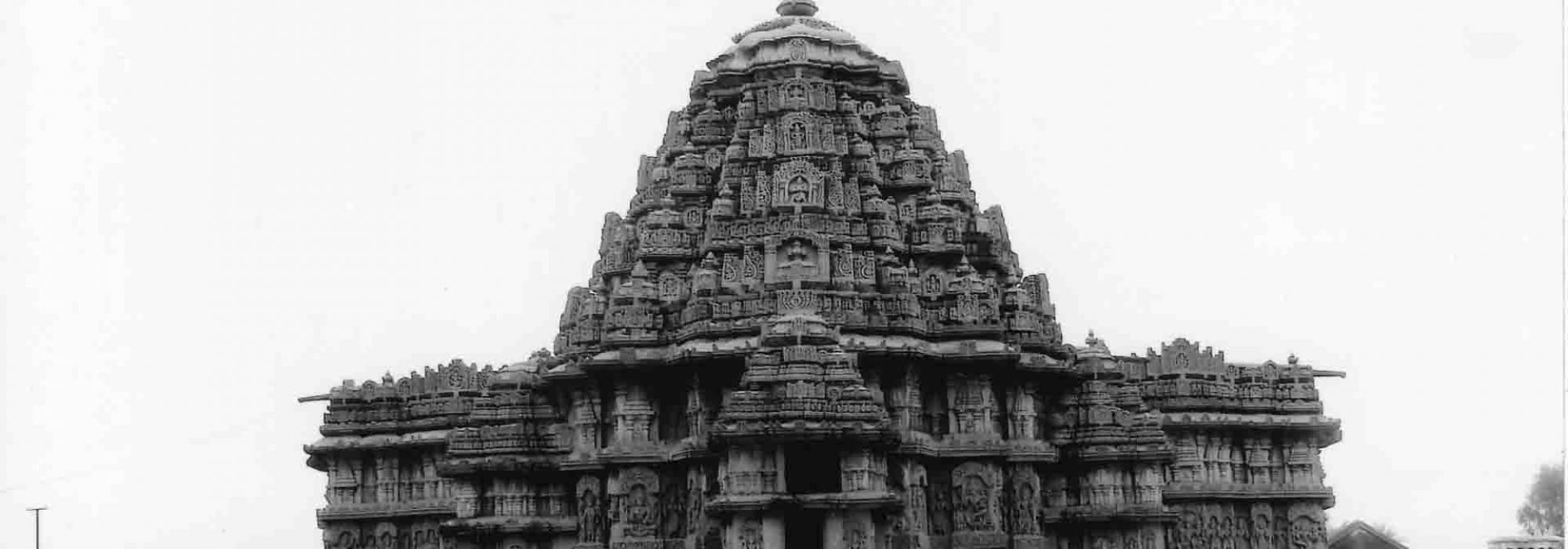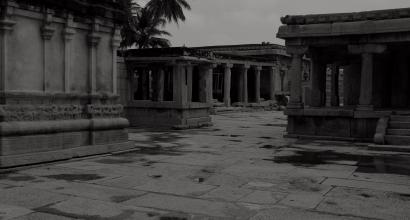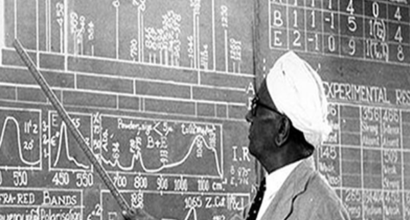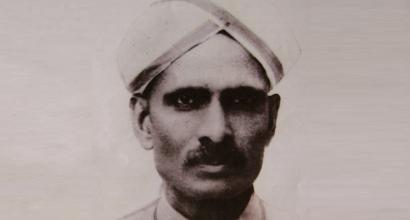Dushtabuddhi Soorappa
Soorappa was a clerk at the Government Printing Press. This is the last thing that should be said about him. What should be mentioned first is that he may be counted as one among the noble people.
In Akkipete, we find the Sri Lakshminarayanaswamy temple. Beside this temple the Sri Lakshminarasimha Bhajana Mandira is situated. I have heard that a rich landlord residing in that area is the patron of the institute. Soorappa oversees the work of that Bhajana Mandira.
Every Saturday evening, a Bhajan procession started out from the Mandira and due to the loud voice of Soorappa even those in the Kashi Vishveshvara temple of Chickpet were able to listen to the bhajans.
Soorappa was intimately familiar with the important aspects of music and its study. He had attained a ripe voice due to regular singing. His pronunciation was crystal clear and the way he rendered the ragas was so emotionally expressive that everyone listened to him carefully, with wide-open ears, whether he sang a kirtana or a shloka.
The presence of Soorappa beautified and enriched festivals like santarpanas. He would give the leaf plates to the visitors, serve them himself, and inquire after their welfare. During the meal, there would be requests for him to render a shloka or two. After being requested by two or three people he would choose a shloka from Ramakarnamrta or Shivanandalahari and sing it melodiously. The people would express their appreciation by saying, “This shloka is far superior than this delicious meal!” Soorappa had compiled stotras and songs that can be sung during meals and had got it printed. I have seen a copy of it in (Venkatasubba Rao) Vajapeyam’s printing press.
As a result of Soorappa’s melodious singing, many such bhajana mandiras were started.
Soorappa was a kind-hearted person. He would always be ready to help those in difficulties and those who are helpless, the moment he came to know about their needs. To him, no work was below his dignity; his rank didn’t matter when it came to work. He would happily undertake work such as sweeping, cleaning the leftovers, etc. He was a tall man with a big face and wide eyes. He always had a cheerful face. Gentleness and modesty flowed from his heart. Whenever someone greeted him, he bowed down and responded with folded hands.
One of my best friends, the esteemed Dr. Gundanna had a great friendship with Soorappa. Whenever he met Soorappa, he would ask, “What’s going on Dushtabuddhi (literally ‘wicked mind’)?” Once I asked Dr. Gundanna about the history of that title given to Soorappa.
Dr. Gundanna said, “This Soorappa is a lover of music since his boyhood and was an amateur singer. He was selected by a drama company when he was a lad. When they presented the play Chandrahasa, young Soorappa played the role of Dushtabuddhi. He performed extremely well. They presented the drama frequently and people praised Soorappa for his role time and again. Thus he became famous by playing the role of Dushtabuddhi. The ways of the world are strange. It gave the title of Dushtabuddhi to Soorappa, who is not at all a wicked person!”
Not only was Soorappa not wicked, he was utterly courteous. His main qualities were kindness and compassion. One always saw compassion in his eyes.
Good conduct and nobility is found not only among famous personalities and high officials. These qualities can also be found in the heart of common people and among the poor and helpless. Soorappa’s life was a good example for this.
Till his last, Soorappa stayed in a rented house. It seems he didn’t have any offspring. He knew what poverty is and so he was a friend to the poor.
Vamanajayanti Venkoba Rao
During 1905-10, Vamanajayanti Venkoba Rao was famous in the connoisseurs’ circle of Bangalore. He worked in the Secretariat or in some other government department as an ordinary clerk.
He wasn’t a tall man; he was lean with brown complexion. He had a small face with shining eyes. His luxuriant moustache was bent over the upper lip. He always had a smile on his face. He wore a turban in the North Indian style. Probably he was a Deshastha Brahmana. As his body was light it was easy for him to jump.
It was a routine with singers in musical concerts to ask gently whether Venkoba Rao was present. The import of this was a mixed feeling of joy and fear – joy, because of the presence of a true learned connoisseur who could appreciate their hard work and fear, because he would not spare them if they missed even a beat.
At a concert, the moment any singer saw Venkoba Rao, he would request him to sit right at the front. Rao would listen with curiosity to the usual alapana and expansion of the raga. “Brilliant!” he would exclaim and nod his head. He would feel enthusiastic whenever the singer began singing the composition. At first he would show the beats of the rhythmic cycle with a finger. Later both the hands would join in, with the beats being indicated by snapping the fingers. Beats would start at the beginning of the Pallavi line, by joining little finger to little finger, middle finger to middle finger and forefinger to forefinger with the sound “Tha tha tha.” With the increasing zeal, his body would jump up. He would recite the solkattu (percussion syllables) such as, “Tha thakita tha,” “Jham tha ka jham tha jham,” “Tha ki ta tha ki ta jham,” etc. The members of the audience sitting next to Rao would leave space for him. His body would begin moving in a semicircular shape and he would traverse here and there. He would forget himself and everything else; he would show the tivragati, chitragati, and ativichitragati to the singer and the mridangam player. While the mridangam player would be astonished and speechless, the audience would be flabbergasted.
When Venkoba Rao was out of his rhythm-mania, he would resemble a baby calf; he was modest, down to earth, always spoke with love. His actions would make other feel that he epitomized friendship.
He was longing to conduct a sangitaseva (musical service) to the almighty. There were thousands of people who organize such programs during Ramajayanti, Krishnajayanti, and even during Narasimhajayanti. During such festivals, well-known musicians won’t be available because they would have agreed to sing at various venues. Vamanajayanti is not a festival celebrated by many. Musicians will be free during that period. Thinking that it was the right time for a poor man like him, Venkoba Rao planned to organize programs during Vamanajayanti. Every year, Vamanajayanti falls in the month of Bhadrapada (September-October). The great musicians of that time were good friends with Venkoba Rao and therefore they agreed to sing without any hesitation.
On one such Vamanajayanti celebrations, there was Mysore Vasudevacharya’s concert. On that occasion, he sang a shloka:
ajinadaṇḍa kamaṇḍalu mekhalā
rucirapāvana vāmanamūrtaye।
mitajagattritayāya jitāraye
nigamavākpaṭave vaṭave namaḥ॥
If my memory serves me right, Acharya started the shloka in Saveri raga in Vilamba-kala (slow tempo) –
a-ji-na-daṇ-ss-ḍa
Venkoba Rao started counting the akshara tala for this. Acharya was thrilled to see this. Music legends such as Dakshinamurti Shastri and Anantashastri who were present in the audience exclaimed, “Aha! Aha! Brilliant!”
Venkoba Rao probably got a salary of fifty or sixty rupees. But the enthusiasm he used to nurture in his heart was worth millions and millions. That’s the fortune of the poor.
This is the fourteenth essay in D V Gundappa’s magnum-opus Jnapakachitrashaale (Volume 2) – Kalopasakaru. Thanks to Śatāvadhāni Dr. R Ganesh for his review. Edited by Hari Ravikumar.




































